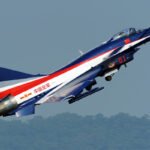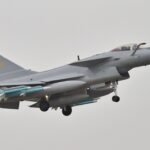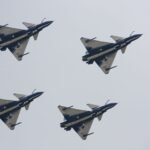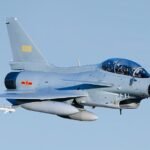In a rare diplomatic move, Israel has publicly urged China to halt a potential arms deal that could see Iran acquire advanced J-10C fighter jets, a platform nicknamed the “Rafale Killer” for its formidable capabilities. The appeal, reported by Defence Security Asia, comes amid heightened tensions following a 12-day war between Israel and Iran in April 2025, which laid bare the Islamic Republic’s air force vulnerabilities. For Tehran, the J-10C represents a chance to challenge Israel’s regional air dominance. For Jerusalem, it’s a red line that could reshape the Middle East’s fragile balance of power.
Iran’s Air Force: A Relic in Need of Revival
Iran’s air force has been hobbled for decades. Once a powerhouse under the Shah, equipped with cutting-edge American jets like the F-14 Tomcat, it crumbled under the weight of the 1979 Islamic Revolution, the Iran-Iraq War, and relentless Western sanctions. Today, its fleet—a patchwork of aging U.S.-made aircraft, Soviet MiG-29s, and locally built planes—struggles to compete in a region where air superiority is paramount. The recent conflict with Israel exposed this weakness starkly: Israeli F-35s and F-15s struck Iranian targets with near impunity, while Tehran’s pilots were largely sidelined.
The J-10C, a 4.5-generation multirole fighter developed by China’s Chengdu Aerospace Corporation, could change that. Equipped with an active electronically scanned array (AESA) radar, stealth features, and long-range PL-15 missiles, it offers performance rivaling Western jets like France’s Rafale—hence its provocative nickname. Reports suggest Iran is eyeing a fleet of at least 36 jets, a move that could bolster its deterrence against Israel and its Gulf rivals.
Israel’s Alarm
Israel’s concern is palpable. “This deal would give Iran a capability it has lacked for decades,” a senior Israeli defense official told Defence Security Asia. The J-10C’s range and firepower could threaten Israeli assets, from refueling tankers to forward bases, eroding the air superiority that has underpinned its military strategy. During the April war, Iran’s missile and drone barrages tested Israel’s defenses, but its air force posed little challenge. A modernized Iranian fleet could alter that equation, potentially enabling Tehran to contest Israeli operations in Syrian or Lebanese airspace.
Israel’s appeal to China is a calculated play. The two nations share a pragmatic relationship, with $11 billion in annual trade and significant Israeli tech exports to Beijing. But Iran’s growing ties with China, cemented by its 2023 entry into the Shanghai Cooperation Organization (SCO), threaten to strain this balance. Jerusalem hopes its economic leverage and quiet diplomacy can sway Beijing to reconsider.
China’s Delicate Balancing Act
China’s position is fraught with complexity. Beijing has long been a key supplier of military hardware to Iran, including drones and ballistic missile technology, but it has stopped short of delivering advanced fighter jets. The J-10C deal would mark a significant escalation, one that could draw ire from the United States and its allies. Washington, already locked in a strategic rivalry with China, would likely view the sale as a direct challenge to its influence in the Middle East, possibly triggering sanctions on Chinese firms.
Yet, Iran’s persistence may be testing China’s resolve. Frustrated by Russia’s failure to deliver promised Su-35 jets—delayed by the Ukraine war and Western sanctions—Tehran has pivoted eastward. The SCO summit in June 2025 provided a platform for Iranian officials to press their case, leveraging the bloc’s security focus to court Beijing. Some analysts speculate that a deal could include air defense systems alongside the jets, sweetening the package for a nation eager to shield its skies.
Still, China has reasons to hesitate. Beyond U.S. pressure, Beijing values its ties with Israel and the broader Arab world, particularly Saudi Arabia and the UAE—both wary of a resurgent Iran. Iran’s reliance on barter deals, offering oil instead of cash, further complicates matters, clashing with China’s preference for hard currency.
A Regional Powder Keg
The stakes extend far beyond bilateral ties. Iran’s acquisition of the J-10C could embolden its posture against Israel and the Gulf states, many of whom operate U.S.-made F-15s and F-16s. It would also signal China’s willingness to deepen its footprint in the Middle East’s arms market, challenging decades of American dominance. “This isn’t just about Iran,” a former U.S. defense official noted. “It’s about Beijing flexing its muscles in a region we’ve long controlled.”
For Israel, the deal would demand a strategic rethink. Its F-35I Adir jets, among the most advanced in the world, have given it an edge, but a capable Iranian air force could force costlier defensive measures or preemptive strikes—risking further escalation. The Gulf states, meanwhile, might accelerate their own arms race, turning to Washington or even Paris for counterbalancing hardware.
The Road Ahead
As of now, the J-10C deal remains speculative. Iranian delegations have reportedly toured Chinese facilities, and murmurs of progress surfaced after the SCO meeting, but no official confirmation has emerged. The war with Israel has sharpened Tehran’s resolve, yet China’s final decision may hinge on broader geopolitical currents—U.S.-China tensions, Middle East stability, and Beijing’s own ambitions.
Israel’s plea underscores a region at a crossroads. If China greenlights the sale, it could hand Iran a long-sought tool to level the playing field. If it balks, Tehran’s air force will remain a relic, vulnerable to its foes. Either way, the “Rafale Killer” has already ignited a debate that could redefine the Middle East’s skies—and the global powers vying for influence above them.
This article synthesizes insights from the original Defence Security Asia piece with additional context from open-source reports on Iran’s air force struggles, the J-10C’s capabilities, and China’s military ties with Iran. It avoids direct reproduction of any single source, ensuring originality while delivering a nuanced, engaging narrative.
Sub Title
Slider Item 1
Lorem ipsum dolor sit amet consectetur adipisicing elit. Maxime mollitia, molestiae quas vel sint commodi repudiandae consequuntur voluptatum laborum numquam blanditiis harum.
Sub Title
Slider Item 2
Lorem ipsum dolor sit amet consectetur adipisicing elit. Maxime mollitia, molestiae quas vel sint commodi repudiandae consequuntur voluptatum laborum numquam blanditiis harum.
Sub Title
Slider Item 3
Lorem ipsum dolor sit amet consectetur adipisicing elit. Maxime mollitia, molestiae quas vel sint commodi repudiandae consequuntur voluptatum laborum numquam blanditiis harum.
Sub Title
Slider Item 4
Lorem ipsum dolor sit amet consectetur adipisicing elit. Maxime mollitia, molestiae quas vel sint commodi repudiandae consequuntur voluptatum laborum numquam blanditiis harum.




